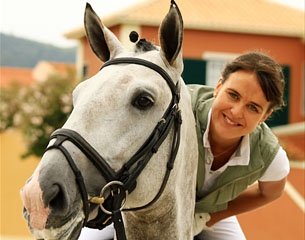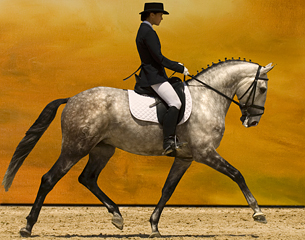
Training a horse from its very beginning, from the basics right up through the levels to Grand Prix, is a great achievement for any rider. There is often something extra special about the horse and rider combinations who have been together from day one. Taking most time to establish the basics -- rhythm, balance, straightness -- and then moving on gradually together takes both determination, patience and feeling. Yet, the true test of a rider's ability and horsemanship is in the re-train.
My pa used to say "buying a second hand car is just inheriting someone else's problems," and like cars a horse that has been trained incorrectly is often very difficult to fix!
A horse begins its training as a supple mould and we as riders must gently knead the dough into the model we desire. A rider's problems therefore become the creases and fault-lines in the horse and the longer the horse is ridden a certain way the more pronounced these fault-lines become. For example, if a rider has a tendency to always apply too much right rein, constantly pulling on this side no matter how much they wish not too, the horse will learn to fix himself against the right rein, locking his jaw so that flexions to the right become almost impossible. This is a minor hassle for this particular rider, as they won't notice the blocked right side of the horse and will instead become comfortable with his way of moving to accommodate the stronger rein.
However when a new rider gets on this horse, they will immediately feel like the right rein is completely useless and unless they apply massive strength the horse will ignore the bend to the right almost entirely. If this example is blown into a major scale and we account for all the little indentations a rider makes to a young horse during the course of training, you can imagine what you get if a bad rider has ridden a horse for a considerable period of time and from the commencement of the horse's training.
That is why a good rider can train a horse from preliminary up to Grand Prix, but a great rider can take a horse that has been trained badly, and retrain him to go well!
When you first get on a badly trained horse, if you are a rider with feeling, it feels terrible, like riding a stressed-out wooden stick, like the ones with the wheel at the bottom that you ride when you're a kid. Purchasing Batialo as a 5-year old was like stepping onto a flowing wave. The only thing I needed to do was to balance myself and try my best not to interfere with his natural balance, rhythm and impulsion. This sounds really easy right? This is actually where so many good horses start their downward slope at the beginning!
A young horse is a blank canvas and a rider must learn to time the training according to the horse's physical and mental development. However, a great majority of riders get on a young horse and take up too much contact, use too much leg, ask with too strong an aid, and try for too much too quickly! Most significantly, the rider tries to use contact and aids to balance themselves on the horse, using their connections to the horse like ropes they can pull on for stability. That is why a young horse is actually very demanding, as a rider must balance himself and merely direct the horse on a solid path.
Young horses are strong and the work is simple, so when a rider cannot balance and instead relies on the use of force to gain control, the young horse will usually learn to accommodate it. The evidence of this unstable beginning is typically reflected later on.
How many times have we seen a good horse get to St George level and then mysteriously disappear? Chances are, during the years of 'accommodating' the rider’s forceful methods, the horse learnt to work in 'compensation' mode and basically does his best to get the job done
For example, every rider has a weakness and if we use the above example the young horse of a rider with a stronger right rein. If this rider trains a young horse from the beginning by relying on the aids for balance, the horse will accommodate by falling through the left shoulder. Over time the horse will then put extra pressure on certain muscles as he cannot establish true straightness. The extra pressure on the joints will increase and as the horse is asked for a greater degree of collection the result will be a break-down caused either by injury or a mindset of "I've just had enough."
 So while it was fun riding the wave of my super young horse, I had to be extra careful not to block him, not to inhibit his movement, nor discourage nor interrupt him establishing his own natural rhythm and swing. The other horse was of the retrain variety and came with a lot of interesting historical markings and mental blockages! I had to begin again, meaning it was back to the snaffle bridle and back to big circles, low and stretching, in slow rhythm, and even balance; for weeks!
So while it was fun riding the wave of my super young horse, I had to be extra careful not to block him, not to inhibit his movement, nor discourage nor interrupt him establishing his own natural rhythm and swing. The other horse was of the retrain variety and came with a lot of interesting historical markings and mental blockages! I had to begin again, meaning it was back to the snaffle bridle and back to big circles, low and stretching, in slow rhythm, and even balance; for weeks!
The most important thing about the retrain is a simple, yet very effective quote: "Ask for much, be content with little, and reward often." (Nuno Oliveira). The minute the horse gave with his back, relaxed and stretched forward into the contact without running, soften the reins, put your inside hand up his neck and stroke him, and use your voice to tell him he is super! How else can a horse know that it is right?
Too many riders get a good bit, and think, oh lets try for more. No, get a good bit, reward, and each time the good bit will be that bit better You don't see a toddler walk for the first time, and then ask him to sprint. Literally you have to take baby steps. From there, once we had established a working stretch and fluid forward transitions without stiffening or coming off the contact, we began more transitions within the pace, i.e. going on and coming back.
This does not have to be exaggerated, just over six strides to increase the length of the steps, followed by six steps to shorten them. Do not change the rhythm or the balance in any way. The change should be subtle and a person watching may not actually see the difference. The emphasis should just be in the feeling and the response of the horse to your light aids!
It has now been three months and finally I am getting wow-moments, in which the horse can collect himself without tension and maintain a forward flowing rhythm and balance as I ask for more impulsion. Introducing now the lateral exercises, I am beginning slowly, ensuring that I never have to make an aid too harsh, one that might scare him back into what I call his "Pepe Le Pew" beginnings.
So the journey on a youngster is tough and requires great patience as the rider learns to wait for the signals from the horse, telling them he is ready to move on in training.
The journey on a second hand horse is even tougher requiring not only patience, but the ability to feel the areas of weakness the horse has developed and accommodate the training accordingly.
Text by Sarah Warne for Eurodressage
Related Links
Part I: Classical Training Defined by a Multi-national Team of Young Riders
Part II: Adapting the Training Once You Start Competing
Part III: Progression, Perfection, and Peace